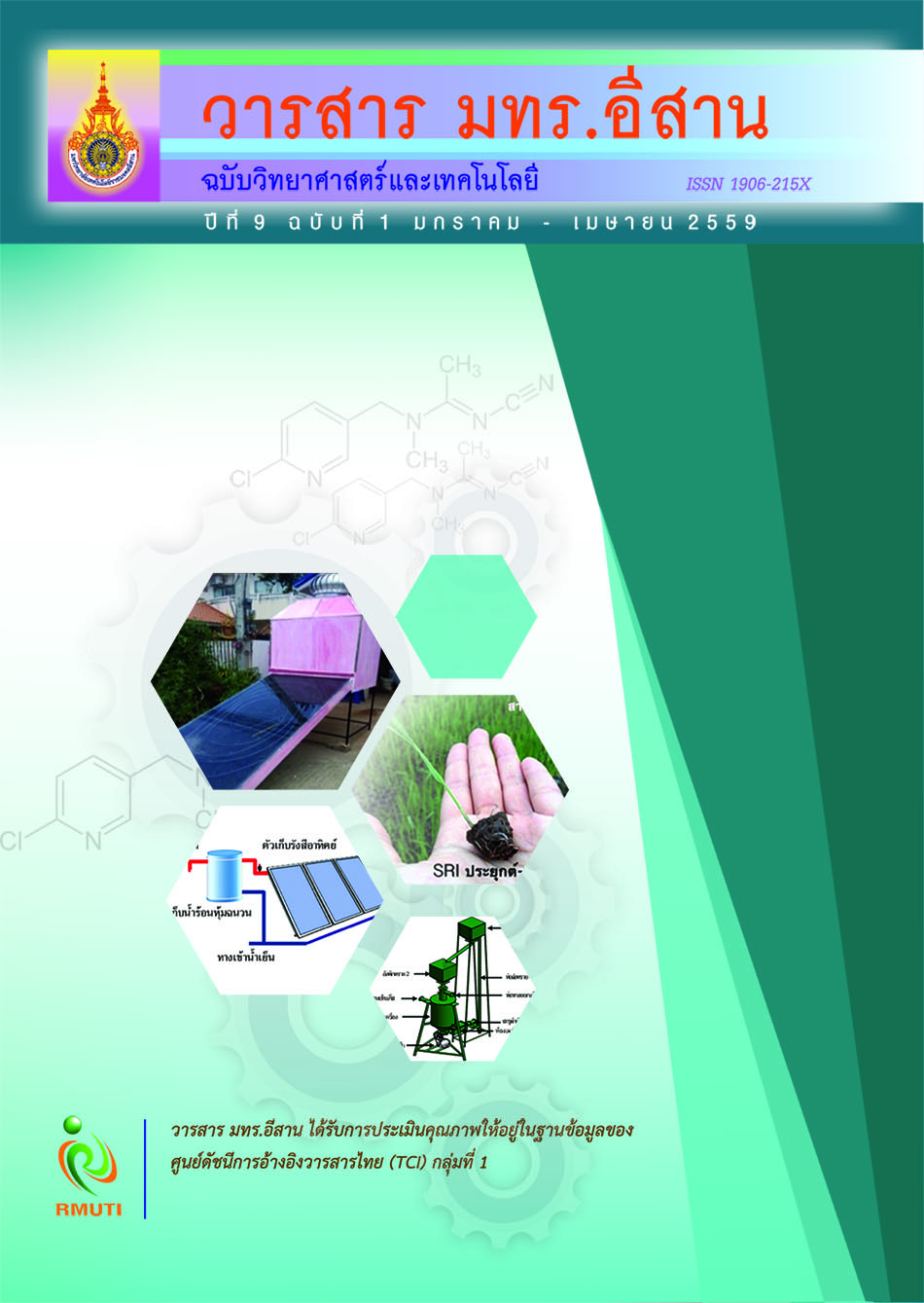คุณภาพทางเคมีกิจกรรมการต้านอนุมูลอิสระ และการทดสอบทางประสาทสัมผัส ของนํ้าส้มสายชูหมักจากมะขาม 4 สายพันธุ์ (Chemical Quality, Antioxidant Activity and Sensory Evaluation of Fermented Vinegars from 4 Tamarind Cultivars)
Main Article Content
Abstract
บทคัดย่อ
งานวิจัยครั้งนี้ได้ทำการผลิตนํ้าส้มสายชูจากไวน์มะขามที่ผลิตจากมะขาม 4 สายพันธุ์ ได้แก่ พันธุ์สีทอง
พันธุ์ประกายทอง พันธุ์ศรีชมภู และพันธุ์ยักษ์ฝักดาบ เพื่อศึกษาคุณสมบัติทางเคมี กิจกรรมการต้าน
อนุมูลอิสระ และการทดสอบทางประสาทสัมผัสของนํ้าส้มสายชูหมักจากมะขามทั้ง 4 สายพันธุ์
เริ่มจากการนำไวน์มะขาม ซึ่งหมักได้ไปปรับปริมาณของแอลกอฮอล์ เท่ากับร้อยละ 8 แล้วเติมเชื้อแบคทีเรีย
Acetobacter pasteurianus ที่มีปริมาตรร้อยละ 10 หมักที่สภาวะอุณหภูมิห้องเป็นเวลา 15 วัน
ตรวจวิเคราะห์ตัวอย่างในวันที่ 0 5 10 และ 15 ในระหว่างการหมักพบว่า ปริมาณแอลกอฮอล์มีแนวโน้ม
ลดลงจนเป็นศูนย์ ส่วนปริมาณกรดแอซิติกมีแนวโน้มเพิ่มขึ้น หลังสิ้นสุดการหมักพบว่านํ้าส้มสายชู
ที่ทำจากมะขามสายพันธุ์ประกายทองมีปริมาณกรดแอซิติกสูงสุดอยู่ที่ร้อยละ 5.40 ± 0.16 และรองลงไปคือ
นํ้าส้มสายชูที่ทำจากมะขามสายพันธุ์ยักษ์ฝักดาบ (ร้อยละ 5.34 ± 0.06) จากการทดสอบกิจกรรม
การต้านอนุมูลอิสระพบว่านํ้าส้มสายชูที่ทำจากมะขามสายพันธุ์ยักษ์ฝักดาบมีกิจกรรมการต้านอนุมูลอิสระ
ดีที่สุดอยู่ที่ร้อยละ 47.47 +- 0.25 และรองลงมาคือนํ้าส้มสายชูที่ทำจากมะขามสายพันธุ์สีทอง (ร้อยละ
32.57 +- 0.41) จากการทดสอบประสาทสัมผัสตัวอย่างนํ้าส้มสายชูพร้อมดื่มจากนํ้าส้มสายชูที่หมักไว้ พบว่า
ผลิตภัณฑ์จากมะขามสายพันธุ์สีทอง ได้รับคะแนนเฉลี่ยความชอบรวมสูงสุดเป็น 5.77 ± 1.45 ซึ่งจัดอยู่ใน
ระดับชอบเล็กน้อย ตามหลักเกณฑ์ 9-point hedonic scale
Abstract
This research had produced tamarind vinegars from tamarind wine from four
cultivars of tamarinds, namely Si Thong, Pra Kai Thong, Si ChomPhu and Yak Fak Dab.
The chemical properties, antioxidant activities and sensory evaluation of these vinegars
were examined. Vinegar fermentation was performed by inoculating 10% (v/v) of
Acetobacter pasteurianus into each of four tamarind wines with the initial alcohol
content adjusted to 8% (v/v). The fermentation was conducted for 15 days at ambient
temperature and sampling was performed at 5-day intervals. It was observed for all
samples that the levels of alcohol decreased continuously over the fermentation period
and almost depleted at the end of the fermentation process, which was consistent to the
increased levels of acetic acid. It was obvious that the highest level (5.40 ± 0.16%) of acetic
acid was observed for the vinegar produced from Pra Kai Thong cultivar, followed by
Yak Fak Dab cultivar (5.34 ± 0.06%). The vinegar produced from Yak Fak Dab cultivar
was shown to exhibit the highest antioxidant activity (47.47 ± 0.25%), followed by
Si-Thong cultivar (32.57 ± 0.41%). As with the consumer hedonic scale, it was found
that the drinking vinegar produced from Si Thong cultivar had the highest overall
acceptability with an average score of 5.77 ± 1.45, which however was equivalent to
the hedonic scale of 9 indicating low levels of the vinegar preferences of the consumers.
Article Details
References
and Hompan, W. (2015). Study of chemical properties, sensory test and antioxidant
activity of Tamarind wine. Poster session presented at the Sakon Nakhon Rajabhat
University International Conference. Sakon Nakhon
Brand-Williams W., Cuvelier, M. E. and Berset, C. (1995). Use of free radical method to
evaluate antioxidant activity. Food Science and Technology. Vol. 28. pp. 25-30
Chailangka, A. (2009). Development of vinegar drink from muiberry juice. Master of
Science (Agro-Industrial Product Development). Chiang Mai University
Chen, Y. H., Hsieh, P. C., Mau, J. L. and Sheu, S. C. (2011). Antioxidant properties and
mutagenicity of Pinus morrisonicola and its vinegar preparation. LWT - Food
Science and Technology. Vol. 44. pp. 1477-1481
Chun, J. E., Baik, M. Y. and Kim B. Y. (2014). Manufacture and quality evaluation of
purple sweet potato Makgeolli vinegar using a 2-stage fermentation. Food science
Biotechnol. Vol. 23. No. 4. pp. 1145-1149
Kim, S. H., Cho, H. K. and Shin, H. S. (2012). Physicochemical properties and antioxidant
activities of commercial vinegar drinks in Korea. Food science Biotechnol. Vol. 21.
No. 6. pp. 1729-1734
Miller, G. L. (1959). Use of Dinitrosalicylic Acid Reagent for Determination of Reducing
Sugar. Analytical Chemistry. Vol. 31. No. 3. pp. 426-428
Ozturk, I., Caliskan, O., Tornuk, F., Ozcan, N., Yalcin, H., Baslar, M. and Sagdic, O. (2015).
Antioxidant, antimicrobial, mineral, volatile, physicochemical and microbiological
characteristics of traditional home-made Turkish vinegars. LWT - Food Science
and Technology. Vol. 63. Issue 1. pp. 144-151
Rangkhawong, P., Issaranuwat, P. and Gaensakoo. R. (2013). Mycelial fermentation in
submerged culture of Schizophyllum commune and its properties. Science and
technology journal. Mahasarakham University. Vol. 33. No. 5. pp. 420-427
Termwong, N. (2008). The relationship of phenolic compounds with antioxidant activity
in plants. Advanced Science. Vol. 8. No 2. pp. 114-124
Waldron, K. W., Johnson, I. T., and G. R. Fenwick. (1993). Food and cancer prevention:
chemical and biological aspects. Royal Society of Chemistry: Cambridge.


